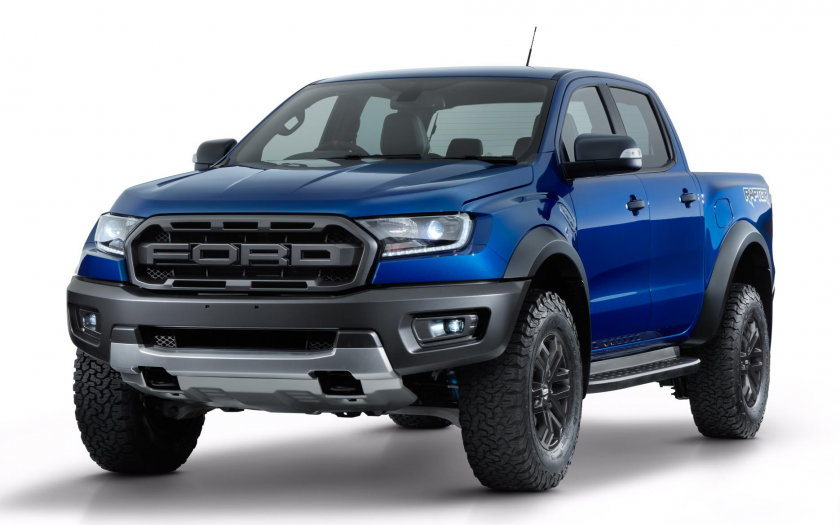Paul Murrell tests the 2019 Ford Ranger Raptor with pricing, specs, ride and handling, safety, verdict and everything the over-50 driver needs to know.
Summary: While it looks superficially like any other Ranger, the Raptor is quite a different beast. And all the better for it.
2019 Ford Ranger Raptor
Pricing: From $74,990 (plus ORC)
Warranty: Five-years, unlimited km
Safety: Not tested (5-star ANCAP 2015)
Engine: 2.0-litre four-cylinder biturbo diesel
Power: 157kW at 3750rpm (doesn’t sound much …)
Torque: 500Nm at 1750-2000rpm (but this number is much more important)
Transmission: Ten-speed automatic
Drive: all-wheel drive, two-wheel drive mode, four-wheel drive high range, four-wheel drive low range, lockable rear differential
Body: 5389mm (long); 2180mm (wide); 1873mm (high) (or, more simply, “big”)
Gross vehicle mass: 3090kg
Kerb weight: 2404kg (154kg heavier than the Wildtrak)
Payload: 758kg (down from 900kg)
Towing capacity: 2500kg (down by 1000kg)
Gross combined mass: 5350kg
Tyres: LT285/70R17
Spare wheel: full size 285/70R17
Turning circle: not stated, but more than other Rangers
Fuel tank: 80 litres
Thirst: 8.2L/100km (combined, diesel)
seniordriver consumption: 9.2L/100km over 489km
[review]
IT WAS ONLY A matter of time before the market for large, boofy trucks (pick-ups, utes, call them what you will) would latch onto delivering a performance variant.
After all, with the demise of the traditional muscle cars (the Holdens and Falcons), their traditional buyers have gravitated to crew cab utes in droves.
So the Ford Ranger Raptor, developed with help from Ford Performance, takes up the mantle for a large number of people.
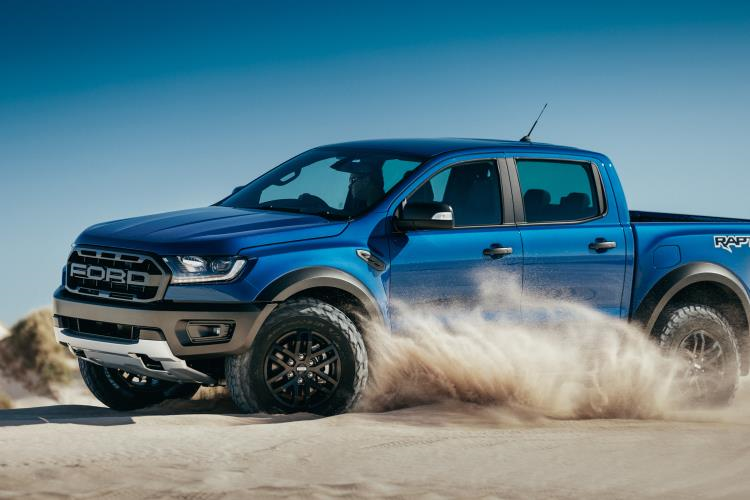
Not an out-and-out tyre shredder
While traditional muscle cars revelled in tyre-smoking performance, ridiculous top speeds and acceleration that was simply unusable anywhere other than a race track, the Ford Ranger Raptor has been designed to a different brief.
Its focus is high-speed off-road work. So its raw numbers won’t bring a lump to the throats of people who still dream of a Falcon GTHO or a Monaro 327.
Value is in the eye of the beholder
Over the years, we’ve come to understand that highly-specified crew cab utes are not cheap. Toyota’s HiLux SR5 is well over $50,000 and the 2.8 HiLux Rugged tops $60,000, as does a high-spec VW Amarok and a top-of-the-line Mercedes-Benz X-Class is pushing $80,000.
Taking that into account, the Raptor isn’t overpriced at $74,990 (plus on roads). However, it does come in at $11,000 more than the next model down in the range, the Ranger Wldtrak biturbo. And a whopping $35,000 more than an entry-level Ranger crew cab.
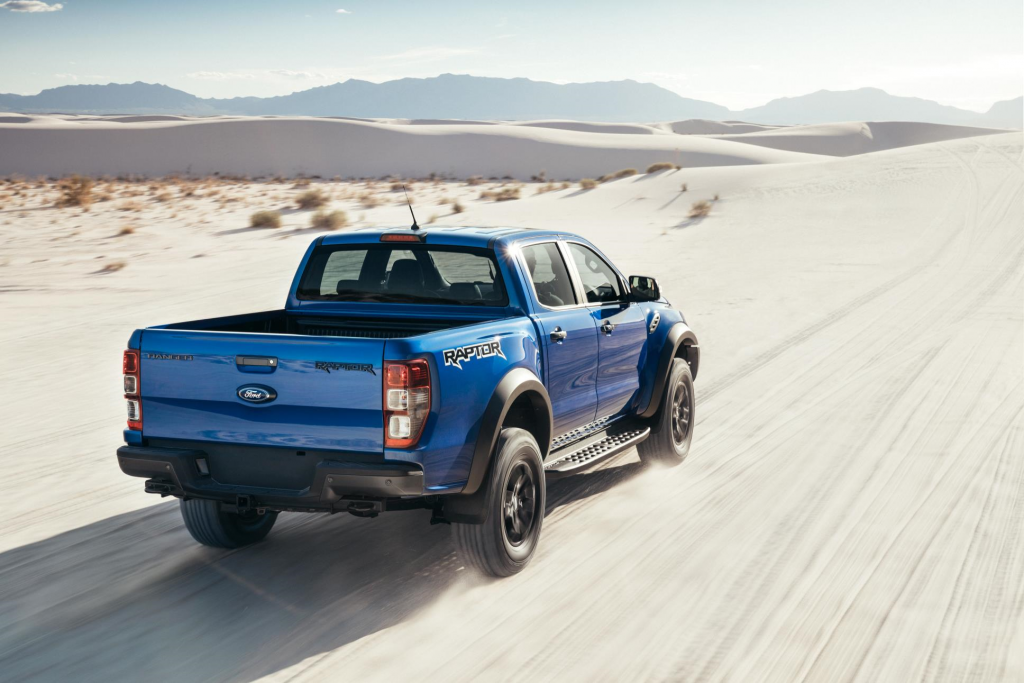
Make it tough
One of the highest priorities for a truck is that it looks tough, and the Raptor succeeds admirably.
It’s actually a lot more removed from the Ranger than you might think, being wider and taller (it’s more like a Ranger with the Everest rear end grafted on) – even the track width has been increased by 150mm – and plenty of chassis reworking, and that means lots of engineering changes. Then there are big wheels, big tread off-road tyres, chunky guards, aggressive bumpers and wheel arch mouldings all adding to the image. In fact, while we were driving it, a lot of people failed to identify it as a Ford.
Whether that’s a good thing or not is up to you.
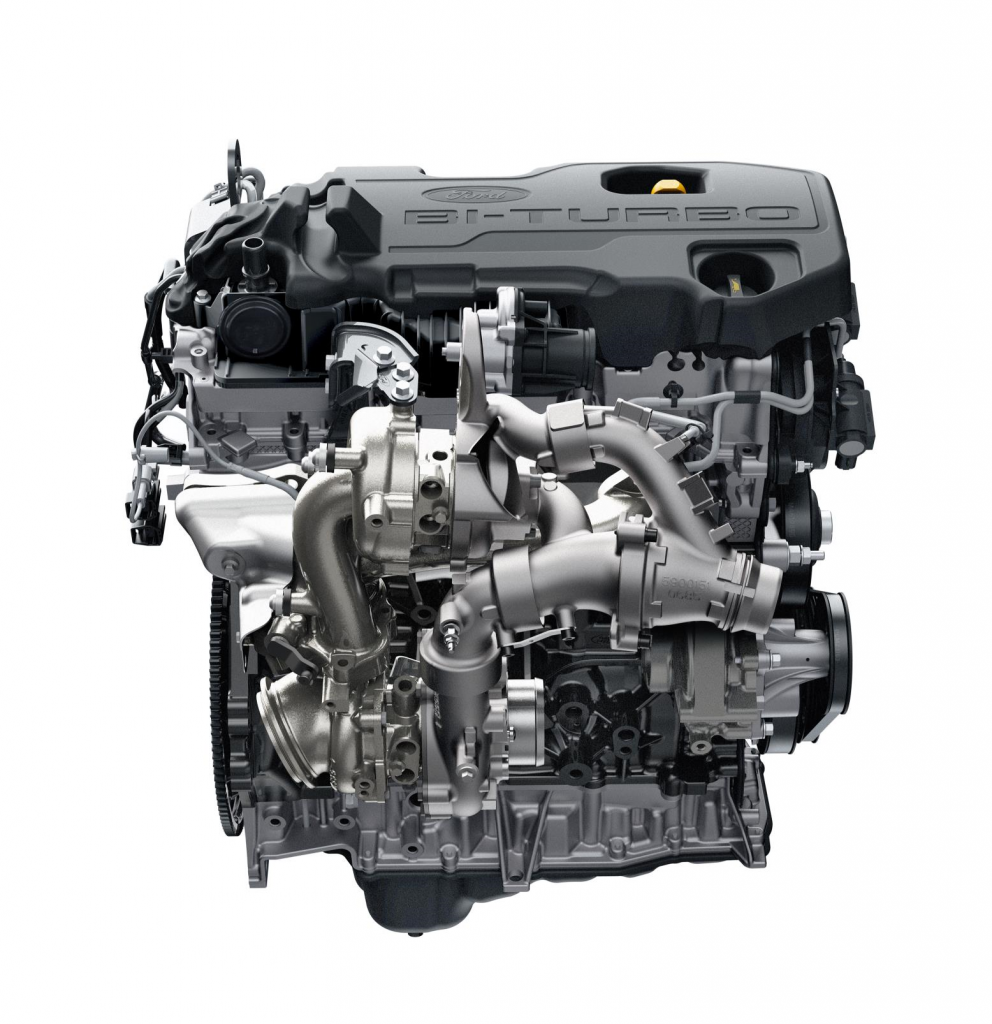
All that with just two litres?
For years, the standard engine in Rangers was Ford’s venerable (and quite agricultural) 3.2-litre diesel. That engine has been replaced by a two-litre twin-turbocharged diesel engine that’s a lot more refined than its predecessor.
It’s mated to a ten-speed (yes, ten!) automatic gearbox that ensures the engine is always (well, almost always) operating in its sweet spot. The exception is in low range where it gets easily confused, but at low speeds off-road, you’ll probably want to manually change gears anyway. Another disadvantage with the transmission is that it won’t accept any gear lower than 6th when you try to change manually to get some engine braking on downhill runs. Even with the (non-adaptive) cruise control set to 100km/h, a good long downhill grade will see you easily exceeding 130 or 140km/h.
Diehards will lament the reduction in load carrying and towing capacity. The new engine means payload has dropped from 900kg to 738 and braked towing capacity has dropped by 1000kg to 2500kg, which may make it unsuitable for some intending buyers.
Where the new engine shows its shortcomings is on the open road when you want to overtake – it feels underdone between 80km/h and 120km/h, right when you need it the most. Nailing the throttle to the floor elicits only a half-hearted response and you wish for a little more in reserve.
Kerb weight has gone up too, thanks to all that additional equipment. The Raptor weighs in at 2404kg, 154kg heavier than the Wildtrak.
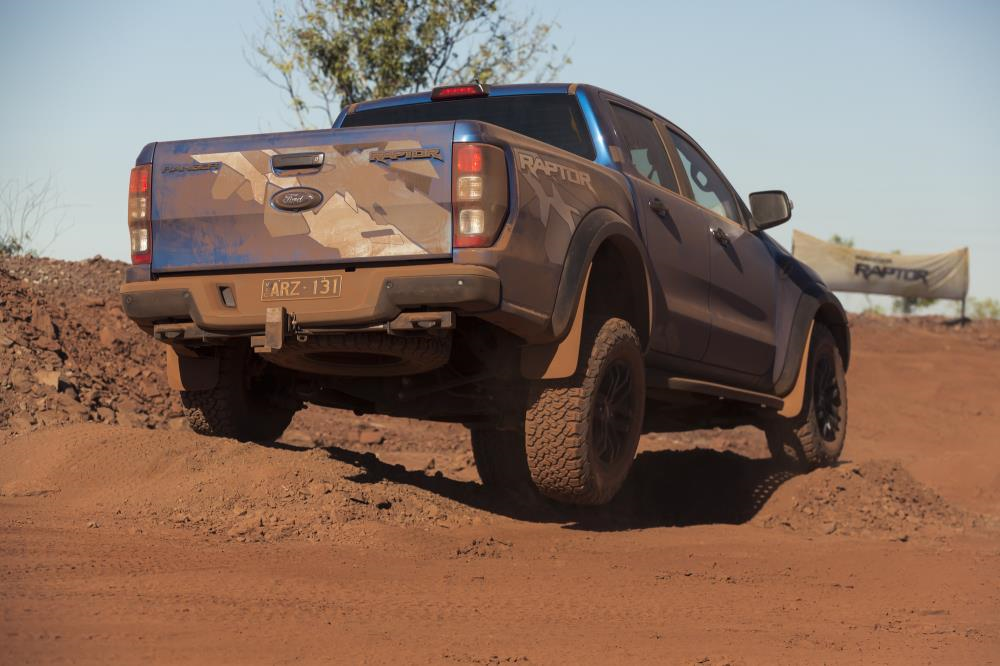
Like an annoying but lovable mate
The Raptor will never be accused of being subtle. But it does have a way of wheedling its way into your affections.
It is surprisingly civilised around town, other than when you try to squeeze it into a shopping centre car park space, or when you have to negotiate a roundabout that you can’t see from the driver’s seat.
Even those aggressively treaded tyres don’t roar like you’d expect, except for one obviously harmonic speed point where they rumble like a half track on concrete. Handling is impressive on-road, and off-road and far more accomplished than you’d expect. It’s good on tarmac, and even better on unsealed gravel.
Fuel consumption is claimed to be 8.2L/100km, which is surprisingly close to the figure achieved by the 3.2-litre Ranger (8.7L/100km) which shows, once again, that a harder working small engine isn’t necessarily much more economical than a lazier larger engine.
The Raptor is a genuine off-roader, with two-wheel high range, four-wheel high range and four-wheel drive low range. There’s also a rear differential lock that can be activated in all three drive modes. There are enough drive modes to keep even the most ardent off-roader happy: normal, sport, grass/gravel/snow, mud/sand, Baja (for maximum off-road performance) and Rock (dulls the throttle and tightens ESC response). Moving between 2WD High, 4WD High and 4WD Low is as easy as it gets, and there are separate buttons for the rear differential lock, the stop/start system and hill descent control.
Another improvement is the fitment of disc brakes to all four wheels.
As mentioned, the tyres look like something the army would specify – BF Goodrich all-terrain tyres on 17-inch wheels.
The rear suspension is also unique to the Raptor. Watt’s linkage and desert racing-derived Fox Racing suspension are high-spec and not cheap, helping justify the Raptor’s price premium. Ground clearance is a lofty 283mm and the combined effect is an approach angle of 32.5 degrees, ramp-over of 24 degrees and departure angle of 24 degrees. Wading depth is 850mm. The extra 30 percent suspension travel also welcome.
To reduce the possibility of setting grass alight, the diesel particulate filter has been moved and it gets a better heat shield.
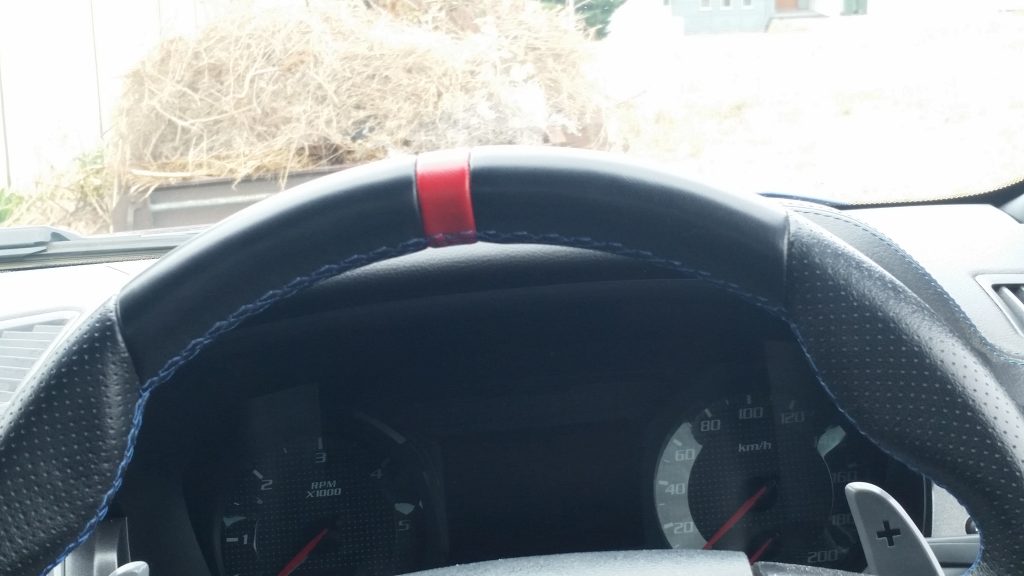
Why isn’t it straight?
The cabin is also a more civilised environment, but perhaps not quite up to the standards you expect of a $75,000 vehicle.
Call me OCD, but one particular annoyance for me was the red strap at the top of the steering wheel (supposedly to help with wheel location during fast off-road work – as espoused by many rally drivers). It simply wasn’t at 90 degrees to the wheel, instead being slightly off angle. It’s the sort of detail that would drive me crazy.
Die cast black magnesium side steps make entry and exit a lot easier, as do big grab handles on the A-pillars. Also appreciated are paddle shifters behind the steering wheel, long enough to grab for without having to grope around.
The seats are big and supportive, with “technical suede” trim around the edges – no, we don’t know what it means either.
Ford Sync3 infotainment system is one of the best around and comes with Apple CarPlay and Android Auto.
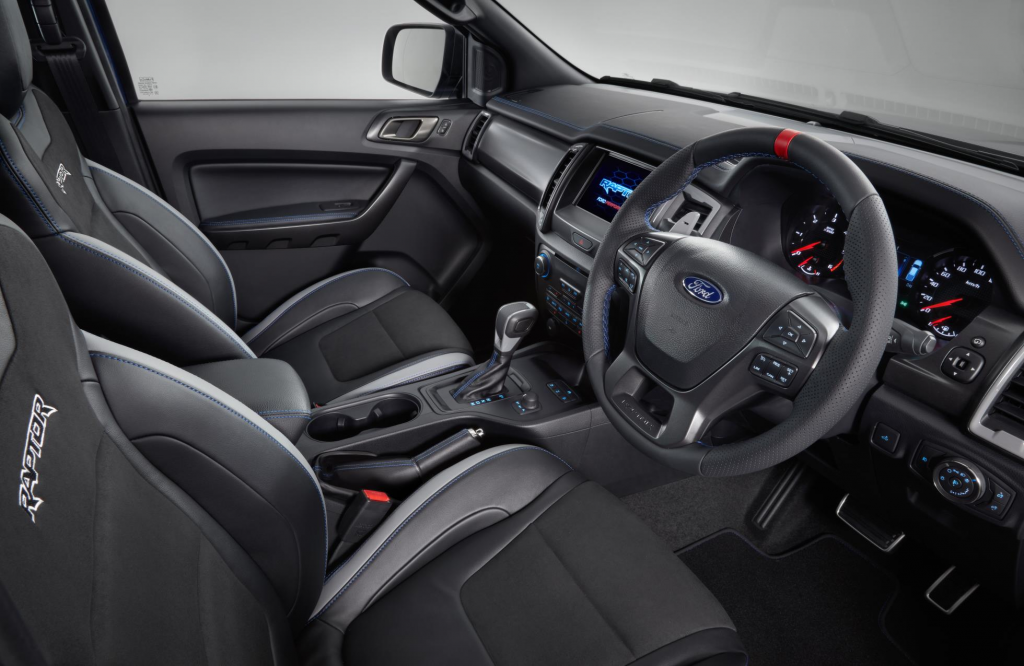
Warranty and service costs
We haven’t been able to forecast servicing costs for the new 2.0-litre engine, but if it stays true to Ford practice, it shouldn’t be too bad.
The five-year/unlimited kilometre warranty will provide long term peace of mind.

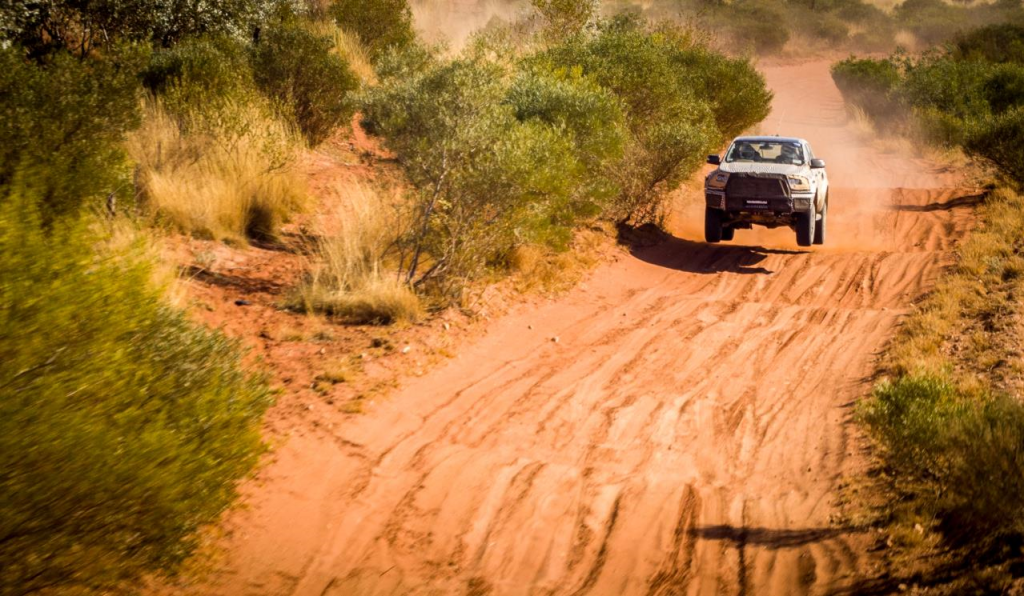
Some annoying omissions
It’s hard to understand why the Raptor misses out on autonomous emergency braking, or, indeed, whether it would still score the five-star ANCAP rating the Ranger achieved in 2015. It misses out on blind-spot monitoring as well; surprising omissions in a $75,000 Ford.
Another let-down is the absence of adaptive cruise control.
Summary.
The absence of AEB and adaptive cruise control is disappointing (they’re on the way, apparently) and more power wouldn’t go amiss. But other than that, the Ford Ranger Raptor has been built to do a specific job, and it does it very well indeed.
